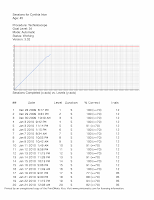
The ability to retain visual sequences in the short-term memory long enough to recall them is crucial for sight-readers.
A person with problems retaining visual sequences because of a lack of the left/right directional tracking is not able to perceive the order of stimuli in which they appear and switch the order of letters in a word or notes in a music.
According to the PTS II Manual, Visual Sequencing "requires Temporal Visual Processing, Visual Attention, Visual Discrimination, Visual Figure Ground, and Visual Speed".
This exercise calls for you to find the characters presented on top of the screen in the same order in which they are presented. Using the right arrow key, you have to move a yellow box over the "first occurrence of the first letter or number in the sequence at the top of the screen, and then press the spacebar on your keyboard". You continue using this strategy until the last letter or number in the sequence has been found.
Variables are:
- Target Type: numbers, upper and lower case letters;
- Codes: combination of letters and numbers sequential order (i.e., ABCDEF, 12345) or random order (i.e., HDUER, 574839);
- Length of Sequence: number of characters in the sequence varies from 2 to 26;
- Number of Characters: number of characters on the screen varies from 40 to 300.
- Goals: to advance to the next level you need less than 2.5 average errors per trial.
It was easier for me to recognize stimuli in sequential order rather then in random order.
As the sequence of characters became longer, I was advised by the optometrist to memorize as much as I could. In order to do the exercise this way, I was required to find the memorized characters, then move my eyes to the top of the screen, back to where I stopped and then come back down and continue where I left. Exactly the same thing as looking at the keyboard while sight-reading and having to go back to the score to the same spot I was previously looking down to.
Please go to http://www.eyecanlearn.com
On this site you are going to find wonderful eye exercises designed for children. However,they can help you visualize what I have been describing.
Bellow the exercises this site offers offers, there are many interesting links to other eye training activities .
.gif)





